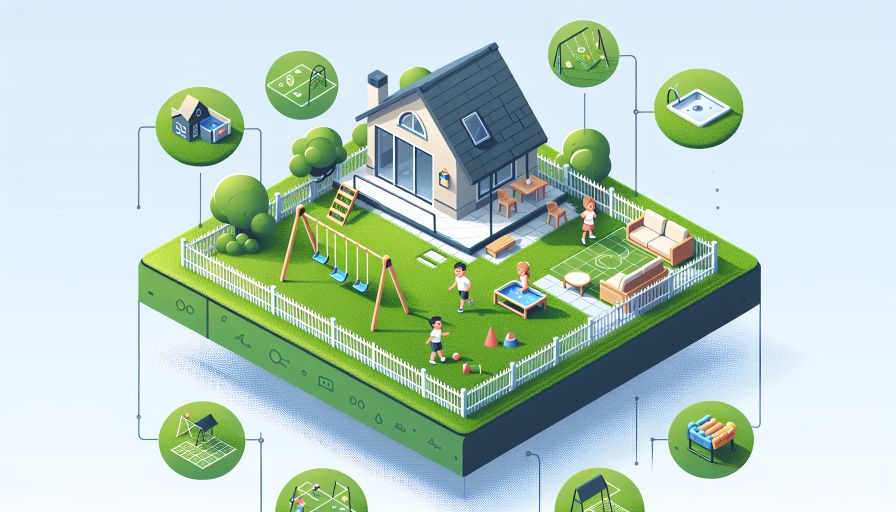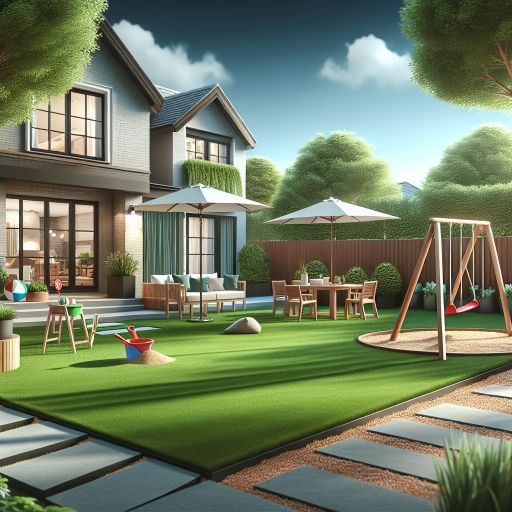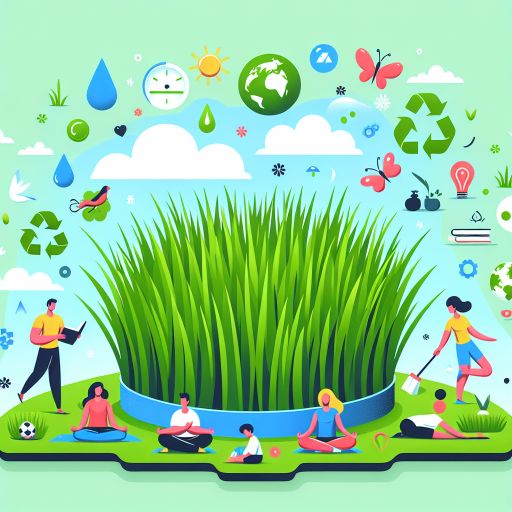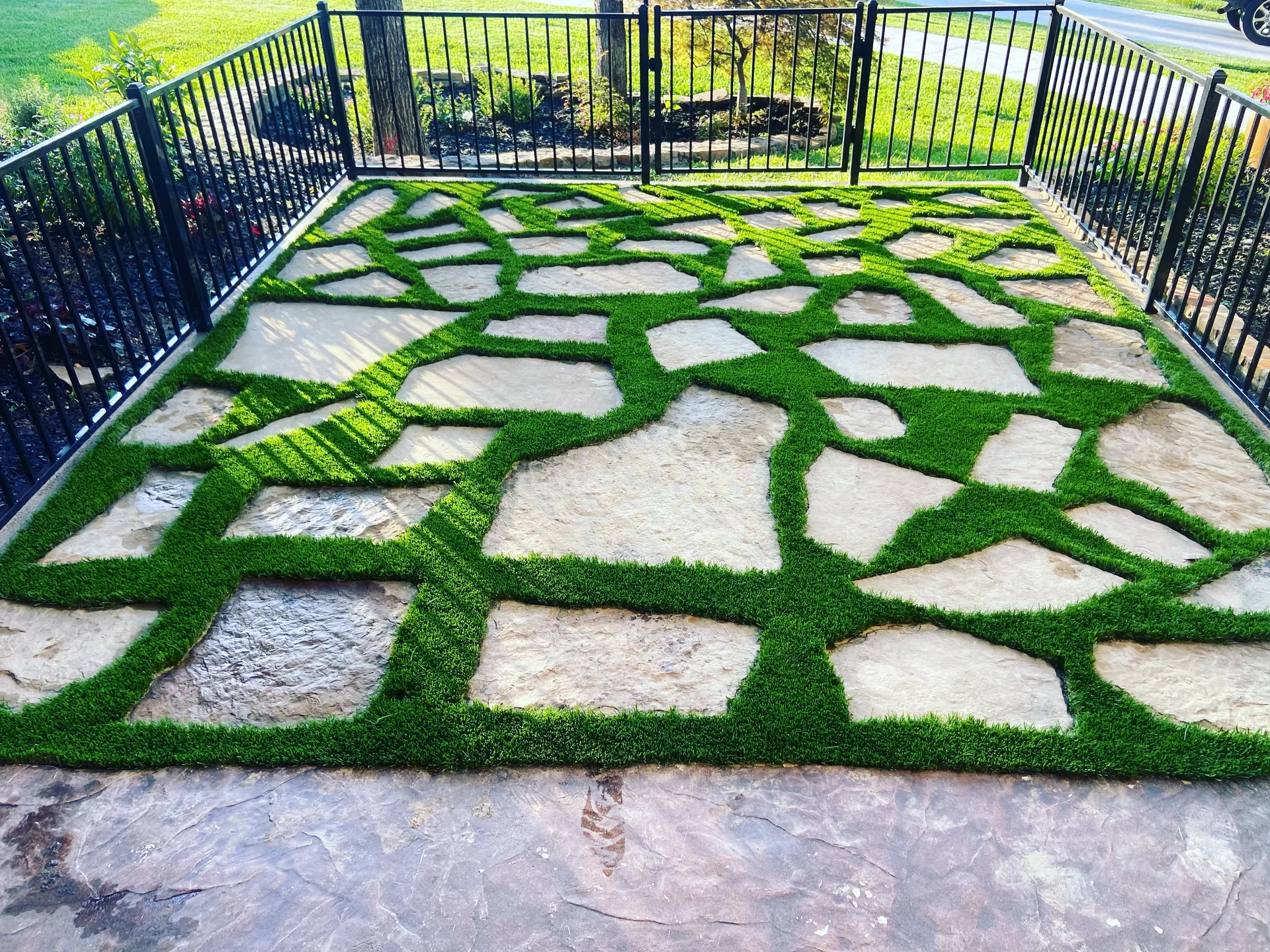
- Introduction to Artificial Grass and Family-Friendly Backyards
- Environmental and Health Benefits of Artificial Grass
- Safety and Durability Features for Family Play Areas
- Cost Analysis and Maintenance Comparisons: Artificial Grass vs. Natural Grass
- Case Studies and Real-World Applications of Artificial Grass in Backyards
- Future Trends and Innovations in Artificial Grass Technology
Introduction to Artificial Grass and Family-Friendly Backyards
Artificial grass, often referred to as synthetic turf, has gained significant popularity in recent years as an alternative to natural grass in residential backyards. Originally developed for sports fields, synthetic turf is now widely used in various settings, including family-friendly backyards.
The appeal of artificial grass lies in its ability to provide a lush, green lawn year-round with minimal maintenance. This makes it particularly attractive to families looking for durable and safe play areas for their children. The advancements in artificial grass technology have made it resemble natural grass closely, both in appearance and feel, providing an aesthetically pleasing and functional surface.
One of the key considerations for families is the safety of their children. Artificial grass addresses this by providing a smooth, even surface free of the common hazards found in natural grass, such as rocks and uneven patches. Furthermore, many modern artificial grass products are made with materials that are free of toxic chemicals, securing a safer environment for young ones.
Another significant factor is the cost-effectiveness over time. While the initial investment in artificial grass can be higher compared to natural grass, the long-term savings are substantial. Unlike natural grass, synthetic turf does not require watering, mowing, fertilizing, or pest control treatments. This not only reduces ongoing costs but also minimizes labor, making it a convenient option for busy families.
The longevity of artificial grass is another contributing factor to its popularity. High-quality artificial turf can last anywhere from 10 to 20 years, far exceeding the lifespan of well-maintained natural grass. This durability makes it a highly practical option for areas that experience heavy use, such as play zones and lawns.
The following table outlines some of the basic comparisons between artificial grass and natural grass:
| Factor | Artificial Grass | Natural Grass |
|---|---|---|
| Water Requirement | None | High |
| Maintenance | Low | High |
| Durability | 10-20 years | Seasonal |
| Initial Cost | High | Low |
| Pest Control | Not Needed | Requires Treatment |
Artificial grass offers a practical solution for family-friendly backyards, combining the benefits of low maintenance, safety, and durability. The consideration of these factors makes artificial grass an appealing option for families looking to enhance their outdoor play areas.
Environmental and Health Benefits of Artificial Grass
Artificial grass offers numerous environmental and health benefits that make it a compelling choice for family-friendly backyards.
Water Conservation
One of the most significant environmental advantages of artificial grass is its water conservation. According to the Environmental Protection Agency (EPA), an average American household uses around 320 gallons of water per day, with about 30% going towards outdoor uses. By replacing natural grass with artificial grass, families can drastically reduce water consumption, conserving this vital resource.
Reduction of Chemical Use
Artificial grass eliminates the need for chemical fertilizers, pesticides, and herbicides. The application of these chemicals on natural lawns poses risks to the environment and human health. The runoff from these substances can contaminate local waterways, harming aquatic life and ecosystems. By opting for artificial turf, families minimize these environmental and health hazards.
Decreased Air Pollution
Natural grass lawns require regular maintenance, including mowing, which often leads to air pollution from gasoline-powered lawn mowers. According to the California Air Resources Board, operating a commercial lawn mower for one hour produces emissions equivalent to driving a new car for 300 miles. Artificial grass, however, does not require mowing, thereby reducing air pollutants and contributing to cleaner air quality.
Allergen Reduction
For families with members who suffer from allergies, artificial grass can offer a significant health benefit. Natural grass can harbor pollen, mold, and other allergens that can trigger allergic reactions. Artificial grass, on the other hand, is allergen-free and can help create a more comfortable outdoor play environment.
Reduced Risk of Injury
Artificial grass provides a more consistent surface for play, reducing the risk of injuries such as sprains or fractures that can occur on uneven natural grass. The evenness and resilience of high-quality synthetic turf make it a safer option for children, who are more prone to falls during play.
Recyclable Materials
Many artificial grass products are now made from recyclable materials and are designed to be fully recyclable at the end of their life cycle. This sustainability aspect reduces the environmental impact, aligning with broader efforts to promote more environmentally conscious and sustainable landscaping solutions.
Heat Resistance
Advancements in artificial grass technology have led to products with improved heat resistance. Some high-end artificial grass variations are designed with heat-reflective materials that keep the surface cooler during high temperatures, making the play areas more comfortable for children and pets.
Conclusion
By considering the environmental and health benefits of artificial grass, families can make informed decisions that support a healthier, more sustainable lifestyle. These benefits contribute to creating safer, more efficient, and eco-friendly play areas conducive to family enjoyment.
Safety and Durability Features for Family Play Areas
When considering enhancements for family play areas, safety and durability are paramount factors. Artificial grass is engineered with features that cater to these needs, offering a dependable and secure environment for children and pets. This chapter delves into the specifics of these features to provide a comprehensive understanding.
Enhanced Safety Features
Advanced cushion layers: One of the primary safety enhancements of artificial grass is the inclusion of advanced cushioning layers. These layers help to absorb impacts and reduce the risk of injuries from falls.
Non-toxic materials: Artificial grass is often made from non-toxic materials, ensuring that playing on the surface poses no chemical hazards to children or pets.
Allergen reduction: Traditional lawns can be breeding grounds for various allergens such as pollen and mold. Artificial grass significantly reduces exposure to these allergens, creating a healthier play environment.
Non-abrasive fibers: The fibers used in artificial grass are designed to be soft and non-abrasive, minimizing scratches and burns that can occur during play.
Durability Enhancements
Weather resistance: Artificial grass can withstand various weather conditions, including extreme heat, cold, and heavy rainfall, without deteriorating. This makes it a durable choice that maintains its quality year-round.
UV protection: Many high-quality artificial grass products are treated with UV inhibitors that prevent fading and degradation caused by sun exposure.
High foot traffic tolerance: Artificial grass is built to endure high foot traffic, making it suitable for areas of frequent activity without showing signs of wear and tear.
Low maintenance requirements: Traditional grass can be vulnerable to pests, diseases, and weed growth, which require regular upkeep. Artificial grass minimizes these issues, reducing maintenance efforts and costs.
Safety and Durability Comparison Table
| Feature | Description |
|---|---|
| Cushion Layers | Absorb impacts and reduce injury risks |
| Non-toxic Materials | Ensures play areas are free from chemical hazards |
| Allergen Reduction | Minimizes exposure to common allergens like pollen and mold |
| Non-abrasive Fibers | Soft surface that prevents scratches and burns during play |
| Weather Resistance | Withstands extreme weather without degradation |
| UV Protection | Resists fading from sun exposure |
| High Foot Traffic Tolerance | Endures frequent activity without showing wear |
| Low Maintenance | Reduces upkeep efforts and costs |
These features collectively make artificial grass a viable option for creating safe, durable, and low-maintenance play areas in family-friendly backyards. The focus on safety ensures a risk-free environment for children and pets, while the durability features provide lasting quality and ease of maintenance.
Cost Analysis and Maintenance Comparisons: Artificial Grass vs. Natural Grass
When considering the financial and maintenance aspects of artificial grass compared to natural grass, there are several critical points to evaluate. This chapter provides an analysis of the initial costs, ongoing maintenance expenses, and long-term economic impact of both options.
Initial Costs
The initial cost of installing artificial grass can be significantly higher than laying natural grass. According to the HomeAdvisor, the average cost to install artificial grass ranges between $5 to $20 per square foot, depending on the quality of the turf and complexity of the installation. In contrast, natural grass sod usually costs between $0.35 to $0.75 per square foot, not including the expense of soil preparation and installation.
While the up-front investment for artificial grass is steeper, it’s important to consider the overall cost over time.
Maintenance Costs
- Watering: Natural grass requires regular watering, which can significantly increase utility bills. The Environmental Protection Agency (EPA) estimates that outdoor water use accounts for nearly 30% of household water usage in the U.S., with a significant portion devoted to lawn care. Conversely, artificial grass does not require watering, which can lead to substantial savings.
- Mowing and Trimming: Maintaining a natural grass lawn involves regular mowing, which can incur costs whether you do it yourself or hire a professional service. The cost of hiring a lawn care service can average between $30 to $80 per visit. In contrast, artificial grass does not grow and therefore does not require mowing.
- Fertilizers and Pesticides: To keep a natural grass lawn healthy, regular applications of fertilizers and pesticides are required. This can add to both costs and labor. Artificial grass eliminates the need for these chemicals, providing a cost-saving and eco-friendly alternative.
Long-Term Economic Impact
Over the long term, artificial grass can prove to be more cost-effective. A study by the Synthetic Turf Council found that homeowners can expect to save on average $3,000 to $5,000 annually on maintenance costs by switching to artificial grass.
Moreover, artificial grass has a lifespan of about 15-25 years, depending on use and material quality. Considering the reduced maintenance and water usage, the initial higher costs of artificial grass can be offset within a few years, leading to significant savings over its lifespan.
On the other hand, natural grass requires ongoing investment in terms of water, fertilizers, pesticides, and lawn care services, which can accumulate to a substantial amount over time.
Conclusion
In summary, while the initial installation of artificial grass can be costly, the reduced need for water, chemicals, and maintenance can lead to substantial long-term savings. Homeowners should weigh these factors based on their specific needs, local climate, and long-term financial planning to determine the most cost-effective option for their family-friendly backyard.
Case Studies and Real-World Applications of Artificial Grass in Backyards
Various families have already turned to artificial grass to enhance their backyard play areas, and the gathered data on these implementations provides valuable insights.
For instance, a survey conducted by the Synthetic Turf Council indicated that homeowners across different regions reported increased satisfaction levels after installing artificial grass. One common reason for this satisfaction is the consistent aesthetic appeal and resilience of artificial turf, which tends not to wear down in high foot-traffic areas as natural grass often does.
Additional studies highlight the versatility of artificial grass in various climates. For example, in regions with arid climates, like the southwestern United States, artificial grass installations drastically reduced water consumption, as these areas no longer require regular watering to maintain lush green lawns. The Environmental Protection Agency (EPA) has acknowledged that installing artificial turf is an effective measure for water conservation in drought-prone areas.
Moreover, municipalities across countries have also initiated projects incorporating artificial grass in public playgrounds and parks due to its durability and low maintenance requirements. These projects serve as practical, real-world examples of artificial grass’s benefits on a larger scale. Feedback from these projects often includes positive notes on the reduced frequency of injuries common to natural grass surfaces, such as tripping over uneven patches or experiencing allergic reactions to pollen.
There are also notable reductions in the use of chemicals, such as fertilizers and pesticides, as artificial grass does not require these potentially harmful substances to remain vibrant and functional. This chemical reduction results in a safer play environment for children and pets, leading to a cumulative positive impact on local ecosystems.
When reviewing installations in private residential settings, it’s evident that many families also value the year-round usability artificial grass offers. Unlike natural grass, which can become muddy or dormant in adverse weather conditions, artificial turf stays in optimal condition regardless of precipitation or temperature changes, thus providing a more reliable play area for children.
Overall, the data from these case studies and real-world applications highlight several tangible benefits of using artificial grass in family-friendly backyards. These installations not only offer a practical and aesthetic enhancement but also contribute to broader environmental and health benefits. As more families and communities adopt artificial grass, the collective experience underscores its efficacy in modern backyard settings.
Future Trends and Innovations in Artificial Grass Technology
The realm of artificial grass technology is continually evolving, driven by advances in material science and a growing demand for sustainable landscaping solutions. Innovators in this field are focused on developing new products that offer enhanced durability, environmental benefits, and a more realistic appearance.
Biodegradable Materials
One major trend is the shift towards biodegradable materials. Manufacturers are increasingly researching options that minimize the environmental impact of artificial grass. These new materials aim to provide the same durability and aesthetic appeal while decomposing naturally at the end of their lifespan.
Enhanced Cooling Technologies
High surface temperatures in artificial grass areas have been a concern, particularly for family play areas. To address this, new generations of artificial grass are being developed with enhanced cooling technologies. For instance, some products now incorporate cooling infills or advanced yarn technology designed to reduce heat absorption.
Sustainable Manufacturing Processes
Another emerging trend is the adoption of more sustainable manufacturing processes. Companies are focusing on reducing energy consumption during production, using recycled materials, and minimizing waste. This move towards sustainability not only benefits the environment but also enhances the appeal of artificial grass for eco-conscious consumers.
Advanced Drainage Systems
Effective drainage is crucial for maintaining a clean and safe play area. Innovations in this area include advanced backing systems with improved drainage capabilities. These systems are designed to quickly and efficiently channel water away from the surface, reducing the risk of puddling and mold growth.
Customization and Aesthetics
Customization options are expanding, allowing homeowners to tailor their artificial grass to better suit their personal preferences and landscapes. New products offer a range of blade shapes, colors, and textures, replicating the look and feel of different natural grass types more accurately than ever before.
Smart Technology Integration
The integration of smart technology is another exciting development. Some artificial grass systems now come equipped with sensors that monitor various parameters such as temperature, moisture levels, and usage patterns. This information can be used to optimize the performance and longevity of the artificial grass installation.
As technological advancements continue to push the boundaries of what artificial grass can achieve, the future looks promising for family-friendly backyards. These innovations not only improve functionality and aesthetics but also address environmental and health concerns, making artificial grass an increasingly viable option for modern homes.


